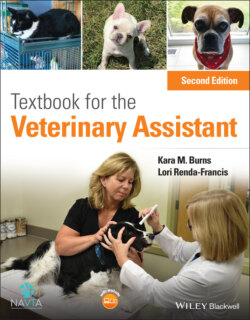Читать книгу Textbook for the Veterinary Assistant - Lori Renda-Francis - Страница 41
Internal organs Digestive system
ОглавлениеThe most cranial structure is the mouth. The mouth, or oral cavity, is a very important part of the digestive system in dogs. This is where digestion begins. The tongue and front teeth help a dog pick up pieces of food, and teeth in the back of the mouth grind the food into smaller particles. A dog has a total of 42 teeth, including incisors and canines, located in the front, and the premolars and molars, which are located in the back. As a dog chews, food is broken up into smaller particles for better digestion by enzymes in the stomach and small intestines. It passes through a small tube called the esophagus that connects the mouth to the stomach via the diaphragm.
The stomach is a sac‐like structure that stores large volumes of food. From the stomach, the food enters the small intestine. There are three parts to the small intestine. The duodenum attaches to the stomach. The middle part is the longest part and is called the jejunum, and the last part is the smallest part and is known as the ileum. It connects to the large intestine. The large intestine connects the small intestine to the anus. Its primary function is to absorb water from feces as needed in order to keep the animal hydrated. Its other function is to store fecal matter that is awaiting passage from the body. The last structure of the intestine is the rectum, which leads to the most caudal structure – the anus (Figure 3.18).
The liver and pancreas are two essential organs that have multiple functions. Both have ducts that secrete special chemicals into the intestine to aid indigestion. They are next to each other anatomically, and a disease of one can sometimes affect the health of both. The gallbladder is a pear‐shaped structure lying between the lobes of the liver (Figure 3.19).
